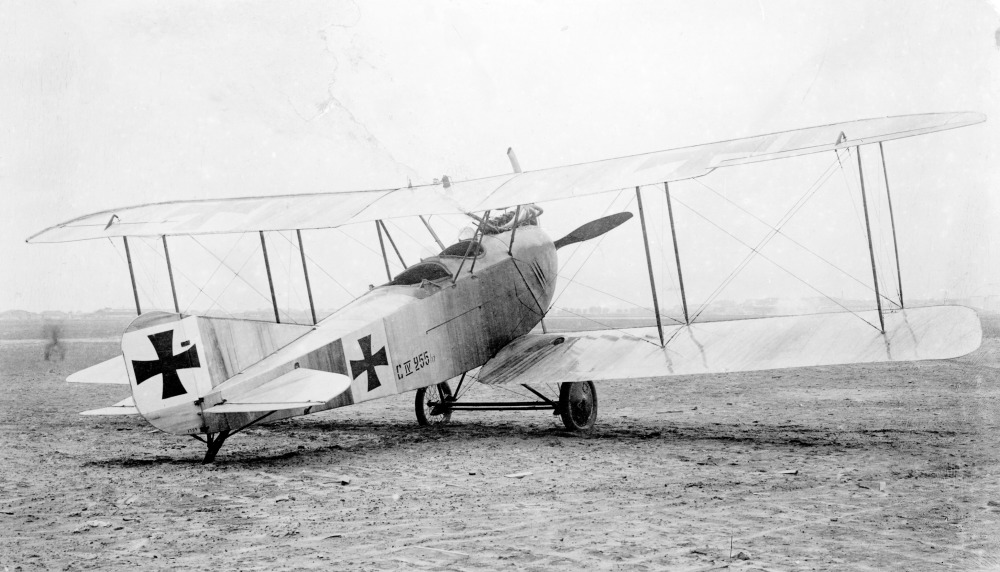AEG C.IV on:
[Wikipedia]
[Google]
[Amazon]
The AEG C.IV was a German two-seat
 ;:
;:

biplane
A biplane is a fixed-wing aircraft with two main wings stacked one above the other. The first powered, controlled aeroplane to fly, the Wright Flyer, used a biplane wing arrangement, as did many aircraft in the early years of aviation. While ...
reconnaissance aircraft
A reconnaissance aircraft (colloquially, a spy plane) is a military aircraft designed or adapted to perform aerial reconnaissance with roles including collection of imagery intelligence (including using photography), signals intelligence, as ...
that entered service in 1916.
Design and development
The C.IV was based on the AEG C.II, but featured a larger wingspan and an additional forward-firing Spandau-type 7.92 mm (.312 in)machine gun
A machine gun is a fully automatic, rifled autoloading firearm designed for sustained direct fire with rifle cartridges. Other automatic firearms such as automatic shotguns and automatic rifles (including assault rifles and battle rifles) a ...
. In addition to reconnaissance duties, the C.IV was used as a bomber escort
The escort fighter was a concept for a fighter aircraft designed to escort bombers to and from their targets. An escort fighter needed range long enough to reach the target, loiter over it for the duration of the raid to defend the bombers, and r ...
, despite proving itself inadequately powered for the role. Nevertheless, the C.IV was easily the most successful of AEG's World War I
World War I (28 July 1914 11 November 1918), often abbreviated as WWI, was one of the deadliest global conflicts in history. Belligerents included much of Europe, the Russian Empire, the United States, and the Ottoman Empire, with fightin ...
B- and C-type reconnaissance aircraft, with some 687 being built and the model remained in service right up to the end of the war.
A variant, the C.IV.N was designed specifically as a prototype night bomber
A bomber is a military combat aircraft designed to attack ground and naval targets by dropping air-to-ground weaponry (such as bombs), launching aerial torpedo, torpedoes, or deploying air-launched cruise missiles. The first use of bombs dropped ...
in 1917, with the Benz Bz.III
The Benz Bz.III was a six-cylinder, water-cooled, inline engine developed in Germany for use in aircraft in 1914. Developing 112 kW (150 hp) at 1,400 rpm from 14.3 L (875 cu in),Smith 1981, p.53. it powered many German military aircraft ...
engine used in other C-types and a lengthened wingspan. Another variant, the C.IVa, was powered by a 130 kW (180 hp) Argus As III
The Argus As III was a six-cylinder, in-line, water-cooled, aircraft engine produced in Germany by Argus Motoren during World War I. The Argus As III produced at 1,400 rpm.Huth, 1920, pp. 232-233
Design and development
Argus Motoren alre ...
engine.
C.IV aircraft saw service with the Bulgarian Air Force (1 machine) and the Turkish Flying Corps (46 machines).
A big number of 91 C.IVs were captured by the Polish in 1919, most in Poznań
Poznań () is a city on the River Warta in west-central Poland, within the Greater Poland region. The city is an important cultural and business centre, and one of Poland's most populous regions with many regional customs such as Saint John ...
during Greater Poland Uprising. Most of them were next assembled and entered service. It became one of basic aircraft of the Polish Air Force, used for reconnaissance, bombing and strafing during Polish-Soviet War in 1919-1920. Most were withdrawn in 1921.Morgała, Andrzej (1997). ''Samoloty wojskowe w Polsce 1918-1924''. Warsaw: Lampart. , p.12
Operators
 ;:
;: Bulgarian Air Force
The Bulgarian Air Force ( bg, Военновъздушни сили, Voennovazdushni sili) is one of the three branches of the Military of Bulgaria, the other two being the Bulgarian Navy and Bulgarian land forces. Its mission is to guard and p ...
;: Luftstreitkrafte
;: Hejaz Air Force - single example, not airworthy
;: Polish Air Force - up to 91 aircraft, used postwar
;: Ottoman Air Force
The Aviation Squadrons of the Ottoman Empire were military aviation units of the Ottoman Army and Navy.Edward J. Erickson, ''Ordered To Die: A History of the Ottoman Army in the First World War'', "Appendix D The Ottoman Aviation Inspectorate an ...
Specifications (AEG C.IV)

See also
References
Bibliography
* * Kroschel, Günter; Stützer, Helmut: ''Die deutschen Militärflugzeuge 1910-18'', Wilhelmshaven 1977 * * Nowarra, Heinz: ''Die Entwicklung der Flugzeuge 1914-18'', München 1959 * Sharpe, Michael: ''Doppeldecker, Dreifachdecker & Wasserflugzeuge'', Gondrom, Bindlach 2001, {{Authority control C.IV Single-engined tractor aircraft Biplanes 1910s German military reconnaissance aircraft Aircraft first flown in 1916